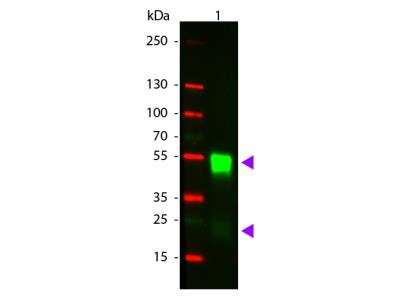Goat anti-Rabbit IgG (H+L) Secondary Antibody [Cy3] (Pre-adsorbed)
Novus Biologicals, part of Bio-Techne | Catalog # NB120-6939


Conjugate
Catalog #
Forumulation
Catalog #
Key Product Details
Species Reactivity
Rabbit
Applications
Flow Cytometry, Fluorophore-linked immunosorbent assay, Immunocytochemistry/ Immunofluorescence, Immunohistochemistry, Immunohistochemistry-Frozen, Western Blot
Label
Cy3 (Excitation = 553 nm, Emission = 569 nm)
Antibody Source
Polyclonal Goat IgG
Format
Pre-adsorbed
Concentration
Please see the vial label for concentration. If unlisted please contact technical services.
Product Specifications
Immunogen
This Goat anti-Rabbit IgG (H+L) Secondary Antibody [Cy3] (Pre-adsorbed) was developed against rabbit IgG whole molecule.
Specificity
Assay of Goat anti-Rabbit IgG (H+L) Secondary Antibody [Cy3] (Pre-adsorbed) by immunoelectrophoresis resulted in a single precipitin arc against anti-Goat serum, Rabbit IgG and Rabbit serum. No reaction was observed against Bovine, Chicken, Goat, Guinea Pig, Hamster, Horse, Human, Mouse, Rat and Sheep serum proteins. This antibody was pre-adsorbed against bovine chicken goat guinea pig hamster horse human mouse rat & sheep serum proteins.
Clonality
Polyclonal
Host
Goat
Isotype
IgG
Scientific Data Images for Goat anti-Rabbit IgG (H+L) Secondary Antibody [Cy3] (Pre-adsorbed)
Western Blot: Goat anti-Rabbit IgG Secondary Antibody [Cy3] [NB120-6939] - Western Blot of Goat anti-Rabbit IgG Pre-Absorbed Cy3 Conjugated Secondary Antibody. Lane 1: Rabbit IgG. Lane 2: None. Load: 50 ng per lane.Primary antibody: None.Secondary antibody: Cy3 goat secondary antibody at 1:1,000 for 60 min at RT. Block: for 30 min at RT.Predicted/Observed size: 28/55 kDa, 28/ 55 kDa for Rabbit IgG. Other band(s): None.
Applications for Goat anti-Rabbit IgG (H+L) Secondary Antibody [Cy3] (Pre-adsorbed)
Application
Recommended Usage
Flow Cytometry
1:500 - 1:2500
Fluorophore-linked immunosorbent assay
1:10000 - 1:50000
Immunocytochemistry/ Immunofluorescence
1:1000 - 1:5000
Application Notes
Use in IHC reported in scientific literature (PMID:33692090). Use in Immunohistochemistry-Frozen, Immunohistochemistry Free-Floating was reported in the scientific literature (PMID: 25446008).
Formulation, Preparation, and Storage
Purification
Immunogen affinity purified
Formulation
0.02 M Potassium Phosphate, 0.15 M Sodium Chloride, pH 7.2, 10 mg/mL Bovine Serum Albumin (BSA) - Immunoglobulin and Protease free
Format
Pre-adsorbed
Preservative
0.01% Sodium Azide
Concentration
Please see the vial label for concentration. If unlisted please contact technical services.
Shipping
The product is shipped with polar packs. Upon receipt, store it immediately at the temperature recommended below.
Stability & Storage
Store at -20C in the dark. Avoid freeze-thaw cycles.
Background: IgG (H+L)
The 4 IgG subclasses, sharing 95% amino acid identity, include IgG1, IgG2, IgG3, and IgG4 for humans and IgG1, IgG2a, IgG2b, and IgG3 for mice. The relative abundance of each human subclass is 60% for IgG1, 32% for IgG2, 4% for IgG3, and 4% for IgG4. In an IgG deficiency, there may be a shortage of one or more subclasses (4).
References
1. Painter RH. (1998) Encyclopedia of Immunology (Second Edition). Elsevier. 1208-1211
2. Chapter 9 - Antibodies. (2012) Immunology for Pharmacy. Mosby 70-78
3. Schroeder H, Cavacini, L. (2010) Structure and Function of Immunoglobulins. J Allergy Clin Immunol. 125(2 0 2): S41-S52. PMID: 20176268
4. Vidarsson G, Dekkers G, Rispens T. (2014) IgG subclasses and allotypes: from structure to effector functions. Front Immunol. 5:520. PMID: 25368619
Additional IgG (H+L) Products
Product Documents for Goat anti-Rabbit IgG (H+L) Secondary Antibody [Cy3] (Pre-adsorbed)
Product Specific Notices for Goat anti-Rabbit IgG (H+L) Secondary Antibody [Cy3] (Pre-adsorbed)
This product is for research use only and is not approved for use in humans or in clinical diagnosis. Secondary Antibodies are guaranteed for 1 year from date of receipt.
